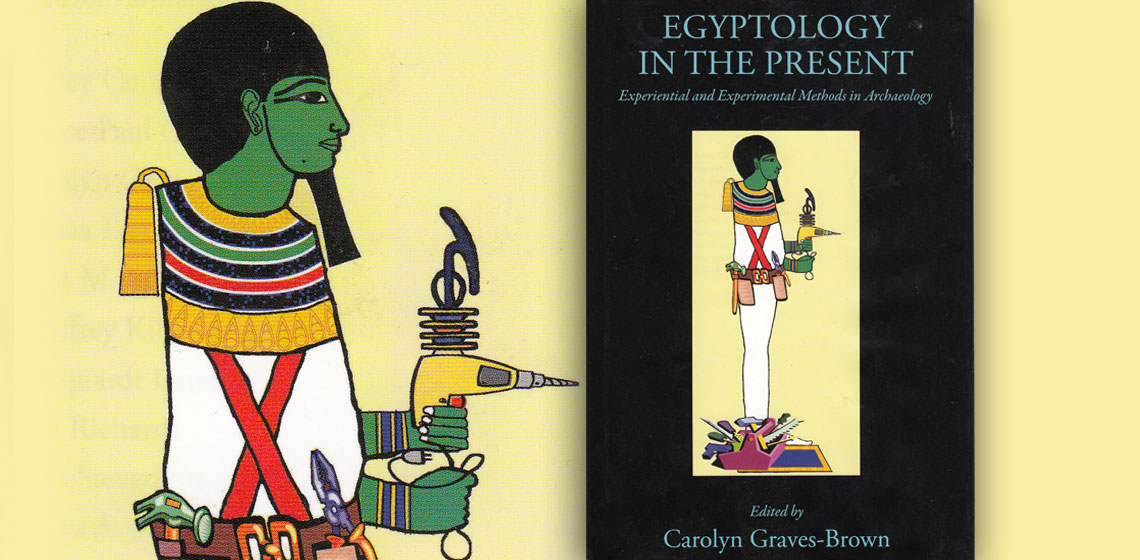
The eye-catching and colourful cover illustration of the Egyptian creator-God Ptah, fully-equipped with modern toolkit, promises an informative journey into experiential and experimental archaeology in Egyptology. In the introductory chapter to a collection of papers presented at a conference in 2010, Graves-Brown provides a good overview and definitions of the two approaches, clearing up many controversial misconceptions. Succeeding chapters can be broadly categorized into a number of diverse topics covering woodworking, stone preparation, embalming, textiles and painting materials. The overviews of pioneering experimental work provide a sound basis for some of the other chapters.
When reading this slim volume, the reader should ideally begin with the chapter “Early Experiments: a view from the Pitt-Rivers Museum” by Alice Stevenson. This provides a useful insight into the beginnings of experimental archaeology in relation to Egyptology. As 19th century Egyptomania spread like wildfire, inspiring curiosity in its antiquities across the world, early experiments were generally informal, taking place in uncontrolled conditions, with the minimum recording of methodology or results. This chapter provides a background into the little-recognized pioneer within the ancient Egyptian context. Recognising the important functionality of material, Lieutenant-General Augustus Henry Lane Fox Pitt-Rivers did ground-breaking work in establishing dates for the Palaeolithic Age in Egypt before progressing to refitting and wear analysis, techniques that have only been actively pursued in the last 40 years. In “Flaxman Spurrell’s Experimenting with Painting Materials”, Ashley Cooke provides an overview on early work with colours, vitreous materials and paint binders based on artefacts from Petrie’s collection. Modern analysis has confirmed the accuracy of his work on different ochres and binding materials.
Graves-Brown and Lund both explore flint knapping techniques, one of the earliest and most visible crafts in the archaeological record. Old Kingdom and Middle Kingdom representations of butchering and re-sharpening of stone knives are investigated by Lund. The depictions of posture and percussion flaking actions are shown to be surprisingly accurate when attempted by the author. In ancient Egypt, as in modern Islamic beliefs, the right was equated with honour and life whilst the left had the opposite connotations. Graves-Brown approaches flint-knapping and retouching with reference to the material and cultural evidence for “handedness” as evidenced by cutting edges. She discusses the motif of knife sharpening in many depictions, commenting on the obvious skill required from her investigations of retouching and handedness.. Denys Stocks literally gets to grip with the materials, tools and techniques used in stone vessel manufacture as he drilled experimental vases. In the second part of the chapter he provides detailed experiments via reconstructed bow drills used in the making of beads, providing some innovative approaches that are not evident in pictorial representations.
Two different methods of replicating the pleating of Egyptian textiles and garments are investigated by Janet Johnstone and Ann Richards. Johnstone evaluates the different types of manual pleating used by laundry workers with the aim of producing a long-lasting, serviceable and practical pleated garment. A complex wrapped dress, as illustrated in New Kingdom depictions and the famous Tarkhan dress was the focus of the replication, which was put to the test by being worn repeatedly over a period of time. Crinkled or pleated textures can occur naturally in textiles, due to the deliberate twisting of yarns. Richards experimented with yarn twist, spacing and thickness to produce some remarkable results of deliberately-produced textured effects that would have withstood continual wear and the rigorous washing process.
Salima Ikram is a recognised authority on animal mummification techniques. In “From meadow to em-baa-lming table”, the reader can follow the techniques used on Brownie the sheep, in an attempt to address questions raised by Ikram’s earlier attempts at rabbit mummification. Manipulation of a larger animal proved to be quite difficult, providing some useful insight into various challenges that would probably have occurred during the human mummification process.
Pearce Creasman exposes some ancient shipbuilders’ technology that would eventually pervade the ancient Mediterranean seafaring world. Based on a number of surviving boats, some excellent models, numerous representations and even limited literary texts, he addresses not only reverse engineering but also virtual reconstructions that are invaluable in addressing the conceptualisation of working vessels. The considerable expertise required by carpenters for working with lathes in fashioning furniture components, is addressed in depth by Geoffrey Killen. Using replica lathes together with bronze and iron chisels, a number of leg shapes were attempted. These indicated that not only was timber machined at high speed with greater precision, as initially thought, but also that developments in this type of technology would probably have been incremental.
In order to fully comprehend ancient technologies and appreciate the crafters’ skill of the past, it is necessary to experience the challenges for oneself. It is sometimes difficult to venture into experimental archaeology without sound mentorship; the chapters were found to be extremely useful for the novice experimenter, like myself, when presenting their findings. Whether a dedicated academic or a fascinated amateur with a desire to explore mummification, woodworking or pleating techniques, this volume ventures beyond the somewhat narrow confines of Egyptology and deserves far wider recognition in the field of experimental archaeology as a whole. Egyptology in the Present will definitely be an asset to your bookshelf and certainly has the potential become a talking point, no matter your own historical period of interest!
Book information:
GRAVES-BROWN, Carolyn (Ed.) 2015. Egyptology In The Present: Experiential and Experimental Methods in Archaeology, Swansea: Swansea University, 280 pp, ISBN 978-1910589021, 62 black and white Illustrations.